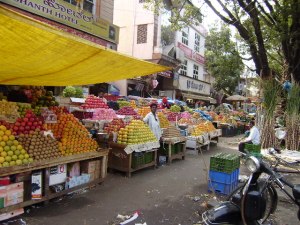My late mother never shopped for fruits and vegetables in the Gandhi Bazaar market. She found that the market was in general consistently overpriced, and if we look at the items that she would buy, it is still the case. For “normal” stuff, you are better off going to nearby “downmarkets” like the one at NR Colony, or even Jayanagar Fourth Block.
So why is the Gandhi Bazaar market overpriced? The answer lies in the long tail. In the book of the same name, Chris Anderson talks about products that are not the most popular, but which has a niche demand. In that he talks about companies such as Amazon or Netflix which are successful not because they do a better job of selling the “bestsellers” but because they are able to service well the “long tail” – items that are not found elsewhere thanks to the high cost of selling.
In other words, it is a liquidity story. If the neighbourhood kirana, for example, wants to sell olives, his costs are going to be high as the rate at which he sells olive bottles is going to be so low that his inventory costs are going to increase, and the risks of ageing and spoilage of inventory also goes up. And he has to spend that much more manpower and effort in managing this extra item, so he decides to not sell this item at all (he will have to charge such a high premium to sell such goods that it doesn’t make sense for the customer to buy it).
Yesterday I bought an “imam pasand” mango in Gandhi Bazaar. Now, this is not one of the “standard” mango varieties that are available in Bangalore. In fact, I had never in my life eaten this variety of mango until yesterday, for the simple reason that it is not generally available in Bangalore. The fruit stall in Gandhi Bazaar, however, stocked it. A neighbouring fruit stall was where I used to source the Dashehri mangoes (common in North India but rare in Bangalore) a couple of mango seasons back. Avocados, which are generally hard to find in “traditional” retailers in Bangalore were also available in every fruit stall in Gandhi Bazaar, as were other not-so-common fruits.
So why did my mother find Gandhi Bazaar expensive? The answer is that the fruit sellers at Gandhi Bazaar stock the “long tail” because of which their general costs of inventory are high compared to competitors who don’t. Thanks to the range, they will have a large number of customers who come to them to buy specifically these “long tail” items. And while they are at it (buying the long tail items), they also end up buying some “normal” items. Customers who come seeking the long tail are usually those that are willing to pay a premium, and thus the shops in Gandhi Bazaar are able to charge a premium for the non long tail items also.
Thus, if you purely look at rates of “common” items, Gandhi Bazaar, a market which offers the “long tail” will always be more expensive than other markets. Anecdotally, along with the Imam Pasand yesterday, I also bought a kilo of “vanilla” Raspuri mangoes, at the rate of Rs. 100 per kg. At the shop down the road, Raspuri was available for Rs. 90 per kg. The shop down the road, however, doesn’t stock Imam Pasand, which means that the price of Imam Pasand in that shop is infinity.
So if you are only looking to buy Raspuri, you are better off going to the shop down the road. If you either want only Imam Pasand, or both Imam Pasand and Raspuri, though, you should go to Gandhi Bazaar! In other words, the “range” that the fruit seller in Gandhi Bazaar offers implies that he can get away without discounting. Theoretically speaking, though, we can say that the fruit seller in Gandhi Bazaar actually discounts on the long tail items by the sheer act of stocking them (thus dropping their price from infinity to a finite number), and he is using this discount to sell his “normal” goods at “full price”. Ruminate on it, while I go off to devour a mango!
